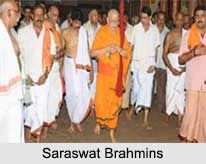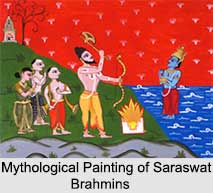 Saraswat Brahmins are a small, highly urbanized community. Saraswat Brahmins are the most revered and esteemed amongst all the Brahmin sub-castes. They form the absolute Apex amongst all the Brahmins sub-castes because they were the original teachers and propagators of the Vedas. They are mentioned in ancient historical texts such as the Bhagwat Gita, Mahabharata, Ramayana and Vedas. This particular group can be divided into 3 main groups:
Saraswat Brahmins are a small, highly urbanized community. Saraswat Brahmins are the most revered and esteemed amongst all the Brahmin sub-castes. They form the absolute Apex amongst all the Brahmins sub-castes because they were the original teachers and propagators of the Vedas. They are mentioned in ancient historical texts such as the Bhagwat Gita, Mahabharata, Ramayana and Vedas. This particular group can be divided into 3 main groups:
•Vaishnavite Goud,
•Smarta Chitrapur and
•Shenvis.
Although their home is in the Kanaras and the region around them, more than 90 percent of the erstwhile Saraswat landowners have migrated to metropolises, such as, Mumbai, Bengaluru and Dharwad in search of either education or employment.
Origin of Saraswat Brahmin Community
According to legend, Saraswat Brahmins are Central Asians who lived along the regions of the former Saraswati River that once flowed parallel to the Indus in present day Pakistan, Kashmir and Northern India. Around 1900 BC, the River Saraswati started vanishing underground and the people on its banks started migrating to other parts of Central Asia and South Asia thus forming sub-communities.
However another theory claims that they are considered descendants of the revered Brahmin, Sage Saraswat Muni who preserved Vedic texts during a calamity in the region which is now Kashmir.
History of Saraswat Brahmin Community
 Quite possibly, the Saraswat Brahmins migrated from Kashmir to Goud (Bengal) and from there to the Konkan coast and Gomantak about the 12th century. The legend of their arrival in Western India relates that Parashurama invited ten of his learned relatives from the northern regions to preside over a "Yajna" at Pande in Goa and it was these scholars who settled down in the 96 villages that Parashurama gifted to them and from which they came to be known as Shahnavi or Shenvi. Their gotras are said to have originated from the names of some of those settlers such as Bharadvaja, Vasta, Kaundinya and Kashyapa.
Quite possibly, the Saraswat Brahmins migrated from Kashmir to Goud (Bengal) and from there to the Konkan coast and Gomantak about the 12th century. The legend of their arrival in Western India relates that Parashurama invited ten of his learned relatives from the northern regions to preside over a "Yajna" at Pande in Goa and it was these scholars who settled down in the 96 villages that Parashurama gifted to them and from which they came to be known as Shahnavi or Shenvi. Their gotras are said to have originated from the names of some of those settlers such as Bharadvaja, Vasta, Kaundinya and Kashyapa.
Society and Religion of Saraswat Brahmin Community
With adaptable ideas the society and religion of the Saraswat Brahmins is contemporary. At the beginning of the 20th century the Saraswats began to migrate from the Kanaras to the cities, chiefly Mumbai and now only a few Saraswat families are to be met within the villages. Their ancestral homes are set in mango, jack fruit and cashew groves. The local people still refer to them as Shambhagru, Shenoy or Patel.
The traditional religion of the Saraswats was evidently a strict Shaivism with each sub-group being led by a different spiritual guru. In more recent centuries, the religious tradition has become more eclectic, with some Saraswats having even adopted the Vaishnavite philosophy.
Position of Women in Saraswat Brahmin Community
As the community is fully literate, social progress had made great strides. Saraswat women are reputed for their beauty and accomplishments. They have more freedom, receive more education and have been exposed to the world outside their homes for decades. They have been working in their own community development projects but doing laudable work as devoted social workers in nationwide organizations. Thousands of Saraswat Brahmins have travelled abroad, bringing a certain amount of Westernisation into their homes and ways of life.




















